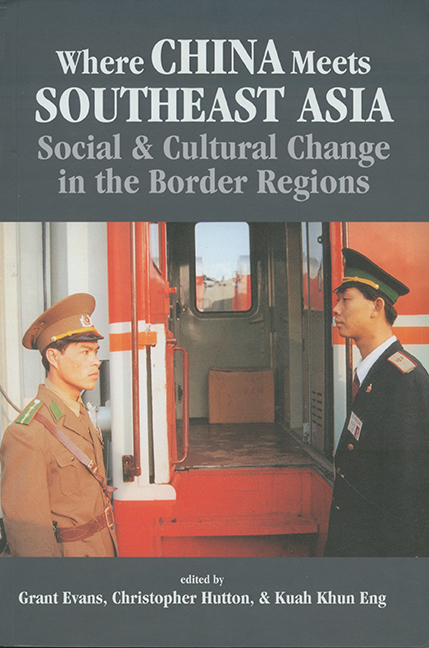Book contents
- Frontmatter
- Contents
- Contributors
- Map
- Introduction: The Disappearing Frontier?
- 1 Where Nothing Is as It Seems: Between Southeast China and Mainland Southeast Asia in the “Post-Socialist” Era
- 2 The Southern Chinese Borders in History
- 3 Ecology Without Borders
- 4 Negotiating Central, Provincial, and County Policies: Border Trading in South China
- 5 The Hmong of the Southeast Asia Massif: Their Recent History of Migration
- 6 Regional Trade in Northwestern Laos: An Initial Assessment of the Economic Quadrangle
- 7 Lue across Borders: Pilgrimage and the Muang Sing Reliquary in Northern Laos
- 8 Transformation of Jinghong, Xishuangbanna, PRC
- 9 The Hell of Good Intentions: Some Preliminary Thoughts on Opium in the Political Ecology of the Trade in Girls and Women
- 10 Cross-Border Mobility and Social Networks: Akha Caravan Traders
- 11 Cross-Border Links between Muslims in Yunnan and Northern Thailand: Identity and Economic Networks
- 12 Trade Activities of the Hoa along the Sino-Vietnamese Border
- 13 Cross-Border Categories: Ethnic Chinese and the Sino-Vietnamese Border at Mong Cai
- 14 Regional Development and Cross-Border Cultural Linkage: The Case of a Vietnamese Community in Guangxi, China
- 15 Women and Social Change along the Vietnam-Guangxi Border
- Index
1 - Where Nothing Is as It Seems: Between Southeast China and Mainland Southeast Asia in the “Post-Socialist” Era
Published online by Cambridge University Press: 21 October 2015
- Frontmatter
- Contents
- Contributors
- Map
- Introduction: The Disappearing Frontier?
- 1 Where Nothing Is as It Seems: Between Southeast China and Mainland Southeast Asia in the “Post-Socialist” Era
- 2 The Southern Chinese Borders in History
- 3 Ecology Without Borders
- 4 Negotiating Central, Provincial, and County Policies: Border Trading in South China
- 5 The Hmong of the Southeast Asia Massif: Their Recent History of Migration
- 6 Regional Trade in Northwestern Laos: An Initial Assessment of the Economic Quadrangle
- 7 Lue across Borders: Pilgrimage and the Muang Sing Reliquary in Northern Laos
- 8 Transformation of Jinghong, Xishuangbanna, PRC
- 9 The Hell of Good Intentions: Some Preliminary Thoughts on Opium in the Political Ecology of the Trade in Girls and Women
- 10 Cross-Border Mobility and Social Networks: Akha Caravan Traders
- 11 Cross-Border Links between Muslims in Yunnan and Northern Thailand: Identity and Economic Networks
- 12 Trade Activities of the Hoa along the Sino-Vietnamese Border
- 13 Cross-Border Categories: Ethnic Chinese and the Sino-Vietnamese Border at Mong Cai
- 14 Regional Development and Cross-Border Cultural Linkage: The Case of a Vietnamese Community in Guangxi, China
- 15 Women and Social Change along the Vietnam-Guangxi Border
- Index
Summary
INTRODUCTION
This chapter concerns broad issues of understanding and interpreting patterns and trends in the region. To the layperson, this may appear to be a task beyond the scope of anthropology, which is usually perceived as being the study of the local and the traditional. But in a world that is becoming increasingly integrated, anthropologists are realizing that it is no longer possible to confine themselves to their traditional field without also bearing in mind the general and the global.
Anthropology also has an important role to play in its guise as a discipline that is sceptical of what Marcus (1998, p. 16) has recently called “naturalized categories” — those categories that we take so much for granted in our everyday lives that they become “natural” to us. These are frequently legitimized by experts in various academic and non-academic fields concerned with the world today, and which try to identify future trends. There is little doubt that the dominant “naturalised categories” in the region have been shaped by the discipline of economics, which has achieved a decisive influence on the interpretation of trends, and the formulation of policy. Some sections of this chapter suggest ways of approaching this important task of “de-naturalization”.
This endeavour has been made a lot easier by the collapse of the Southeast Asian economies in 1997–98, because this “meltdown”, as it is often described, has thrown the confident predictions of the economists, political scientists, and management gurus who saw only the rise and rise of the Asian “tigers” into spectacular disarray. There were many writers whose works were prominently displayed in bookshops throughout the region, and whose every word was earnestly absorbed by audiences on lecture tours which spanned the globe. It will suffice to mention two here by way of illustration: Ohmae (1995) and Naisbitt (1995).
- Type
- Chapter
- Information
- Where China Meets Southeast AsiaSocial and Cultural Change in the Border Regions, pp. 7 - 27Publisher: ISEAS–Yusof Ishak InstitutePrint publication year: 2000



